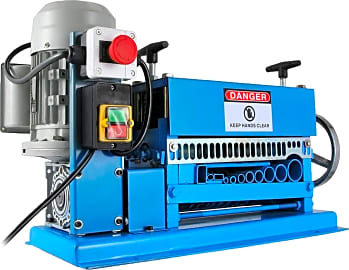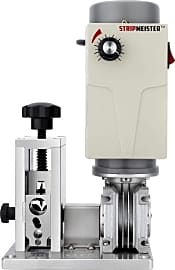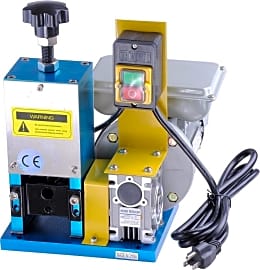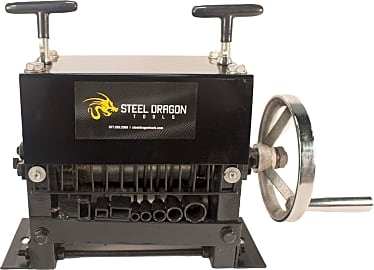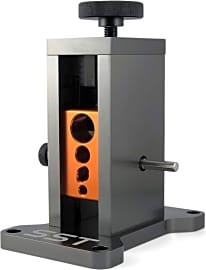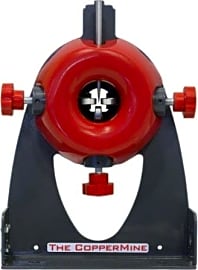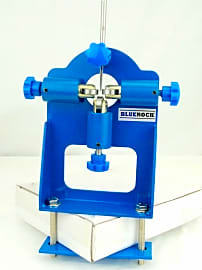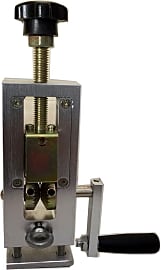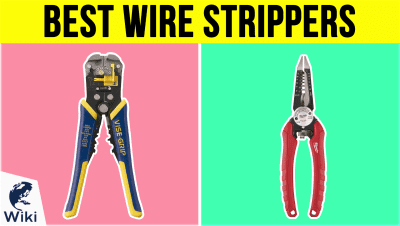The 10 Best Wire Stripping Machines

This wiki has been updated 33 times since it was first published in March of 2017. Whether you're a busy electrical contractor or a construction-site dumpster diver, if you expect your local scrapyard to give you their best price for your waste wire, you've got to make sure that it's stripped clean. Our selections for this category contain a mix of lightweight, manual models; heavy-duty, motorized units; and even a hybrid selection powered by drill. When users buy our independently chosen editorial choices, we may earn commissions to help fund the Wiki.
Editor's Notes
February 10, 2021:
It ended up being quite a busy round of updates. While the Klein Tools Kurve, Irwin Vise-Grip and Weletric Mini were all eliminated based on our feeling that these handheld selections would be a better fit for our list of wire strippers, we also ended up removing the StripMeister Original Automatic. The Original Automatic was still a fine selection, but between our new addition of the SST Industrial — an alternative drill-powered model that features both a better price and nicer design than the Original Automatic – and the StripMeister E250 – essentially a motorized version of the Original Automatic, which is much more convenient – we felt that it was time to phase this option out.
Our other new additions this time around were the Happybuy 11-Channel — a motorized version of our enduring selection, the Happybuy 10-Channel; and the BlueRock WS-212 — a two-horsepower monster that can chew through 75 feet of insulation per minute.
August 09, 2019:
At this time, we still believe that the StripMeister Original Automatic and LFaize Hand Crank are strong choices for moderate use in situations where a hand-held unit won't provide adequate functionality. The former is the sturdier of the two, and it’s also automatic, so it’s fine for bigger jobs. We also added the manual Steel Dragon Tools WRM33. It’s on the larger side, so you’ll need space for it, but this also means it doesn’t feel wobbly like some smaller, lighter units. For those who need a handheld, portable tool, we kept the Klein Kurve by Klein Tools and added the Irwin Vise-Grip. Many like that the Irwin model is self-adjusting, but to some users, it doesn’t seem to work equally well with all wires. But both are relatively inexpensive and have comfortable handles, making them a fine addition to your tool chest.
Special Honors
Control Laser NoNic For industrial use that requires absolute precision, the Control Laser NoNic may just be your best bet. There are both handheld and bench-top options to select from, but as you may imagine, they require quite an investment. controllaser.com
Bluerock Stripinator The Bluerock Stripinator is a huge unit at over 250 pounds, but it can handle 125 feet per minute and offers two sets of rollers. Of course, its size means that there are some shipping limitations and requirements, but for those with heavy-duty needs, it’s still one to consider. bluerocktools.com
In the Beginning, There Was A Light (Bulb)
The wires were mostly left exposed, secured to the structure with ceramic knobs.
It can be hard to imagine living in a world where the smartest people alive have barely even managed to figure out light bulbs. For example, from a modern perspective, flying a kite during a lightning storm seems like it could be a remarkably poor idea. But the truth is, it took 200,000 years of humans living on Earth for some of the most intelligent ones to focus their energies on this shockingly powerful phenomenon.
We have none other than legendary inventor Thomas Alva Edison to thank for the introduction of commercially viable electrical systems. Many people know about the fateful, final day of 1879, when the Wizard of Menlo Park debuted his newly refined light bulb alongside a first-ever wiring system that connected an entire neighborhood. He knew that if his new system of bulbs and circuits was ever to see widespread adoption, it would require a permanent and safe means of transporting electrons. So he developed one of the first readily available conductors, and was awarded its patent in 1892.
Insulation materials still had quite a long way to go before conductors could co-exist in tight spaces, so the first home wiring setups were relatively complex networks of cables running underneath floorboards and in crawlspaces, called knob-and-tube systems. The wires were mostly left exposed, secured to the structure with ceramic knobs. Similar tubes would protect them from moisture and physical damage when they passed through floorboards or walls, and they were often wrapped in a braided cotton sheath wherever they were susceptible to moisture.
Understandably, installing dozens of separate cables throughout a building was costly and time-consuming, and as electrical wiring became a common installation and remodeling task, it got far more complex. In the mid-1900s, the method was overtaken by the use of nonmetallic-sheathed constructions, the gold standard of electrical wiring in the modern age.
Layers Upon Layers
There are different configurations of modern Romex wire, which, like Kleenex and Xerox, saw its most popular brand become a colloquial term for the entire field. Many large projects beginning around the turn of the 20th century employed wire surrounded by a layer of lead, and later aluminum. This provided increased safety and long-term reliability, though installation was pain-staking and the material itself rather expensive. Inside any sub-type, however, you'll find traditional insulated wire hard at work
The simplest NM wire consists of two parts: a conductor surrounded by insulation, most often a pairing of copper and a blend of polymers.
The simplest NM wire consists of two parts: a conductor surrounded by insulation, most often a pairing of copper and a blend of polymers. Despite frequent use of the word "flow," electricity does not run down the middle of a wire, but rather oscillates on the surface of the metal, just beneath the sheath. As home wiring advanced, engineers developed numerous braided and molded insulation types that surpassed previous materials in maximum load, heat dissipation, as well as water and fire resistance. By the 1940s, conduit became the order of the day, compiling dozens of wires together and turning former rat's nests into relatively clean projects. In the 21st century, metal, plastic, and nylon tubing are positioned inside the walls throughout entire houses to provide safe and easily serviceable power.
All these developments mean that today's wires are, functionally speaking, far removed from Edison's original patent, although they're still in agreement conceptually. In fact, humanity now has a strong enough grip on the flow of electrons that we're seeing power cords integrated with highly sensitive cables such as Cat-7 and USB-C. All of these follow the same basic rules, and use updated materials that cut interference and signal bleed to levels unimaginable a few decades ago.
Why A Wire Stripper
We may not consider it every time we plug our phone charger into an outlet, but the first requirement of wiring installation is simply gaining access to the actual metal conductor. A wire cutter, pair of pliers, or even a simple knife can do the job in a pinch, given the right touch and special attention to safety. On the other hand, if you have more than a couple ends to splice, you'll want all the work to be consistent and of high quality. Naturally, a wire stripping machine is a no-brainer for many professional electricians and contractors.
A wire cutter, pair of pliers, or even a simple knife can do the job in a pinch, given the right touch and special attention to safety.
Others will find quite a bit of utility in these machines, as well, due to the explosion of DIY electrical projects in recent decades. After a handful of auto or marine stereo installations, you'll definitely see the value in having a mechanical helper to remove just enough nylon. Additionally, secondhand wire is often still in great shape, even if its insulation is too degraded for use. In these situations, savvy builders and artists can not only reclaim the materials for scrap metal, they can even recycle and re-purpose old wire, allowing it to provide charge another day.
The most basic of these tools is a lot like a standard pair of scissors, except instead of a pair of blades, it's covered in holes of various sizes that correspond to particular gauges. These convenient handheld tools are ready at a moment's notice, and can often crimp and cut wire, too. A step above those are spring-loaded automatic options, which physically secure the wire and then remove the insulation, without any pulling or twisting from the handyman — a simple squeeze of the handles is all they require.
Scrap collectors and career electricians should consider a stationary stripping machine, which comes in both manual and electric styles. While they're a bit more complex than the smaller types, they're exceptionally easy to use, with some models able to automatically process dozens of feet of wire per minute. The right choice depends on the user's work volume, the space in their workshop, and their willingness to put in extra elbow (or in this case, wrist) grease to get the job done safely and effectively.


